 By Pepper Parr
By Pepper Parr
February 17, 2015
BURLINGTON, ON
Two oddities: the word neighbourhood does not appear in the current Official Plan and Shoreacres Blvd is not within the boundaries of the Shoreacres Community Study.
What isn’t at all odd is that the people who live in the community want some say over the rate at which their community undergoes a change.
The Community and Corporate Services Standing Committee was reviewing a report from the Director of Planning on the the option of a Character Area Study for Shoreacres as part of the Official Plan Review.
 Neighborhood character studies have taken on a bit or a social cachet in Burlington. Two years ago there were two of the things launched; one at Indian Point, which went nowhere and the residents want to get out of what they started.
Neighborhood character studies have taken on a bit or a social cachet in Burlington. Two years ago there were two of the things launched; one at Indian Point, which went nowhere and the residents want to get out of what they started.
A second community character study was launched in Roseland where small developer/contractors were roaming the streets looking for property they could purchase and divide into two lots or build what have come to be called monster homes.
In the spring of 2014, the demolition and rebuild of a dwelling in the Shoreacres Community led to a grassroots community discussion about a growing trend of redevelopment and its related impacts in the area. This community discussion took place through informal gatherings, petitions and conversations with media.
The Director of Planning was instructed to report back to Development and Infrastructure Committee in Fall 2014 on whether to conduct the study based on the following:
scope and timing of the study and the impact on the completion of the Official Plan Review Process
additional resource requirements
preliminary policy directions, zoning and design guidelines.
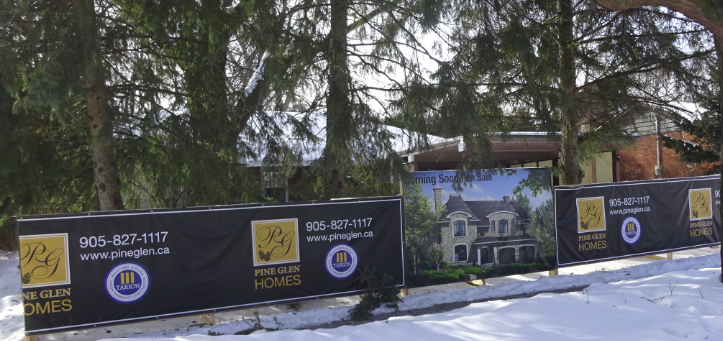
Selling the dream. The house proposed is seen as so out of design and proportion from the house behind the hoarding by the residents – they fear the character o their neighbourhood will be changed too quickly,
The planners organized a preliminary community meeting to consult with residents regarding the primary issues facing the neighbourhood. Staff concluded that the built form and housing stock in a section of Shoreacres is relatively homogeneous. While redevelopment has been occurring in the larger neighbourhood that comprises Shoreacres (generally described as south of New Street, west of Walkers Line and east of Appleby Line), there is a particular area within Shoreacres that has similar characteristics that distinguish it from other areas of Shoreacres.
This area can generally be described as those properties located south of Spruce Street and north of Lakeshore Road, on both sides of Goodram Drive on the west and on both sides of Juniper Avenue on the east. Common features within this area are, most notably, the predominance of bungalows and absence of two-storey dwellings, low pitch rooflines, mature trees, the absence of sidewalks on some streets and the usage of siding as a common cladding material.
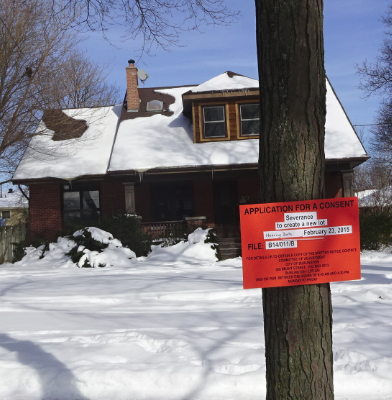
This resident seeks consent from neighbours to sever their property
Staff, in consultation with the Ward Councillor, established an initial boundary for this area comprising approximately 185 homes and mailed out meeting notices and questionnaires to these addresses.
A community meeting to discuss recent development in the Shoreacres Community took place last July – 65 people attended, which some residents pointed out later amounted to one third of the residents in the study area – more than the percentage that voted in the municipal election.
Staff took the residents through the basics of planning and gave them an update on the Character Area Study for Roseland and Indian Point.
The primary issues that were raised at the meeting and through questionnaires, phone calls and emails can be summarized into the following topics:
a) There is inadequate public notification for demolitions, rebuilds and minor variance applications
b) There is inadequate protection of existing mature trees on both public and private property
c) The size of the study area as shown on the meeting invitation is too scoped
d) The architectural style of new homes (modern architecture, flat roofs) is incompatible with the existing neighbourhood
e) Redevelopment has adverse impacts on the privacy of adjacent property owners
f) The permitted building height (10 m for peaked roof residential dwellings) is incompatible with existing dwellings
g) The permitted number of storeys (2 storeys maximum) is incompatible with existing dwellings
h) The applicable Zoning By-law provisions for corner lots are inappropriate for the neighbourhood
At the community meeting, staff provided several responses regarding the above concerns as summarized:
a) Public notification requirements for development applications are established in the Ontario Building Code and the Planning Act and, for Ontario municipalities, there are no legal notice requirements that accompany the issuance of site plan approval, demolition permits and/or building permits. The public notification requirements for minor variance applications are set out in the Planning Act and implemented by the City. Specifically, a sign is posted on the subject property and notice is mailed to all property owners within 60 m of the subject application.
While the various act set out what is required there is no reason why the planning department can’t do more than the acts call for
b) The City of Burlington does not have a private tree by-law that can protect trees on private property. The City recently considered the implementation of a Private Tree By-law in July of 2013, but did not proceed with this initiative. The protection of trees on public property is managed through the site plan process and the protection of boundary vegetation is protected through the Forestry Act and reviewed during the site plan process.
c) The study area shown on the meeting invitation is a preliminary study boundary and is still subject to change.
d) Architectural style cannot be regulated through the Planning and Building Department, but the Urban Design Guidelines for Low Density Residential Zones and the site plan process allow for review of architectural elevations and an opportunity to influence architectural style with the objective of ensuring compatible development.
e) (e-h) The concerns relating to privacy impacts, building height, number of storeys and corner lot zoning provisions all relate to the existing Zoning By-law requirements that apply to this area. During the meeting, staff noted that a zoning review could be conducted by City staff to determine whether or not changes to the Zoning By-law would assist in managing some of the changes being experienced by the neighbourhood. Based on the comments that have been received to date, staff is of the opinion that a zoning review, including additional public consultation, in this area is warranted.
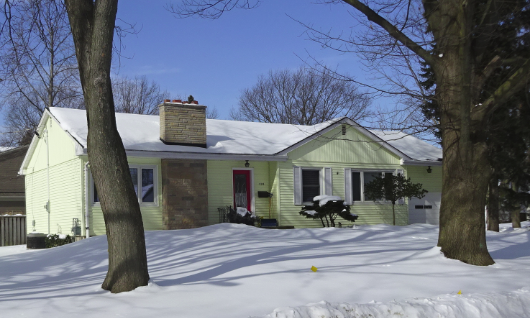
Another large, spacious corner lot.
Mayor asked what the average size of these houses was – between 1200 and 2200 sq. ft. but Faccenda said the neighbourhood was not yet ready for significant development. Albert Faccenda said a neighborhood will look like what the people who live there want it to look like. People sell their property and get the best price they can and developers build on the property they bought. We build what the market wants he said. He added that the present bylaw would allow 7 to 8 thousand sq. ft. homes; that sent a shudder through the council chamber.
Councillor Meed Ward asked what Faccenda wanted to see changed – the lot coverage could be more generous he replied. A bungalow get 35% lot coverage; a 1 1/2 storey can have up to 30% coverage and a two storey gets 25%
Strategy/Process
The city is currently conducting a Character Area Study for Roseland and Indian Point as part of the Official Plan Review. Significant insight has been gained as a result of the consulting team’s work and staff is recommending a study for the Shoreacres neighbourhood with narrower scope.
Subject to Council approval of the Terms of Reference, the scope of the Shoreacres Study would identify the compatibility impacts of recent development within the neighbourhood, and determine what, if any, measures should be taken to modify policy, zoning and development application process (e.g. minor variance or site plan applications).
The proposed study will be lead independently of the Official Plan Review. Any Official Plan policy amendments that may arise from this study would be conducted as a City- initiated Official Plan Amendment. This project could be instructive to the upcoming Zoning By-law Review, particularly for residential neighbourhoods south of the Queen Elizabeth Way
The Shoreacres community, as defined in the reports is certainly very distinct. |Mary Alice St. James said there were more than 40 corner lots in the area which gives developer/contractors opportunities to put much larger houses into the community and fundamentally changing the look and feel of the streets.
The community is one of the most desirable and priciest in the city. Ken Crew, who delegated, said he and his wife needed ten years to put together the money needed to buy a house.
They like their community just the way it is and while they say they are not opposed to development they don’t want to see all that much in the way of change. The developer/contractors love the area – they can sell almost anything they build at a very pretty price.
The question really comes down to – how much say do the people in a community get to say about what is permitted in the way of new construction.
The houses are not small; the lots are not small, however most are not large enough to be divided.
At what point do the homes in place now become outdated and no longer meet the needs of new families?
Is the character of a neighbouhood something municipal bureaucrats should be protecting or should the market determine what can be built and sold for a profit?
Director of Planning Bruce Krushelnicki is very sympathetic to the interests of the residents of the community. His planner Rosa Bustamante thinks it is more of a zoning exercise – the residents see their community being chewed up by economic interests.
Aldershot has much the same kind of housing on the water side of Plains Road west of King Road.

This is the community the residents want to conserve – their hope is that a neighbourhood character study will result in zoning or bylaws that keep that exists.
Niagara on the Lake has zoning and bylaws that determine what the look and feel of the streets in the commercial core of that city will look like – and they keep a very tight rein on what gets done. That community is a destination and is good business.
Does a small neighbourhood deserve the same kind of attention? The third of the community that showed up for the meeting, in the middle of July when many people were on vacation.
What do the residents of the community want? There were just two delegations. Ken Crew, a long time resident who was joined by his neighbour Ron Fleming
“To our neighbourhood, your approval of a City-funded and timely Character Study is of incredible importance he said.
“We have followed with great interest and support the development of the Character Study for Roseland and Indian Point. However, we are not Roseland or Indian Point. Our values and needs, while sharing some commonality with the Roseland study, are specific and unique to our mature neighbourhood.
The vast majority of the homes are smaller bungalows, with some 1 ½ storey homes and more recently a few bungalofts. There is also a very strong sense of community within this group of taxpaying homeowners.
“More recently however, our area, like others in Burlington, is under constant attack from developers with no ties to the local area or its residents, who are simply buying up the existing mature homes, demolishing them, and replacing them with the largest monster homes the city will allow under the current bylaws and regulations – or buying up corner lots and severing them for multiple large or monster homes. Their sole interest is profit, not the residents.
“A prime example is the new home recently erected on Oak Crescent, approximately 3 times the size of all other homes in the area, dwarfing its neighbours, with wrap-around large balconies, ruining the privacy of all homes surrounding it. It totally destroys neighbourhood character and streetscape and has reduced the existing tree canopy.
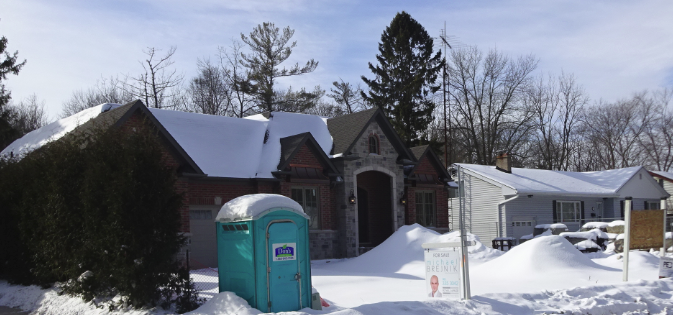
Residents in the community don’t see how this new home fits in with the bungalows in place now. And that porta potty has to go.
“The footprint of the original corner house was changed and flipped 90 degrees in the opposite direction, while all of the plans and changes were done without the existing residents being aware of the changes, and without having any opportunity to provide input or discussion on this new monster home.
As well as being highly passionate about the character of the area we live in, we are also quite aware that change in our neighbourhood is inevitable, and in fact we have no serious opposition to change. We are very open to the proper, controlled, and measured changes that can be done without compromising the values we hold so dear. We know the City needs an effective and enforceable set of rules to control development and we want to work with, not against city planners to develop the appropriate set of rules to retain our unique community character. That is why this study is so critical.
“Burlington is a great place to live as recent studies have shown, and we are proud to be citizens of this excellent community. BUT, if City management does not recognize the rapidly increasing levels of citizen concern and involvement, particularly in the housing sector – whether it is the demand for Character Studies, the plans to build 28 story buildings in the wrong areas, or building large developments in areas where we already have major unresolved problems, like sewage and drainage, then we run the risk of allowing the destruction of some of the very core principles and characteristics that so many resident taxpayers find so vital to their continued happiness and desire to stay here as long term residents. The uniqueness of these neighbourhoods is a large part of what makes Burlington such a great place to live.”
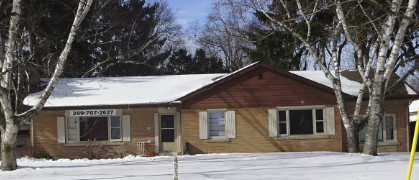
Another corner lot – this one on Lakeshore Road. The owner wants you to call them.
“Time is of the essence. We have little time left to save this truly unique neighbourhood. Our earlier attempts to obtain an interim by-law to restrict monster homes in our area were unsuccessful, so we recognize this timely Character Study is our only option. “
Albert Faccenda a developer/contractor who has built eight homes in the community said there is no market for bungalows in Shoreacres; that he built one and lost his shirt. The Faccenda statements were in direct contract to what everyone else was saying. Faccenda finds that to be the case on most of the occasions he speaks. He told the residents of Roseland that their 100 foot lots were ’dinosaurs’ or more correctly, properties he would like to purchase and redevelop. He told Indian |Point residents that the Character Study being done in that neighbourhood was going to devalue their property.
Mary Alice St. James, an elementary school principal and a community resident gave a polished presentation extemporaneously – and made all the points that had to be made. She stressed that people want to move into the community and she doesn’t believe they want to move in and build homes that are out of character with what is already in place. “They wanted our neighbourhood” she said. “The situation we are faced with now is not nice” she added.
Councillor Craven said that while he appreciated the St. James passion “it is exactly what we saw at Indian Point but “once people got into the issues they got a better sense as to what could be done and at Indian Point they decided they didn’t want this study to go any further.”
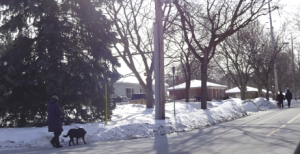
On one of the coldest winter days – the people in the community still get out with their dogs for what is a brisk walk.
Craven said he thought “this issue may become less clear than you think it is now” referring to the Shoreacres residents.
Councillor Sharman was curious to see the outcome and added that he “was not comfortable with the way we are going about this”.
But they are going to “go about it”. The decision to proceed with the study will be made at a city council meeting before the end of the month.
Right now this Council has to determine just what the 2015 budget is going to look like.



















Just to clarify a point or two. I was not at the meeting in July where 65 people attended. But having attended many of these meetings in the past I assure you that not all were in support of the character area study. The 65 number (remember this number as it is a get out of jail free card) probably included members of city staff, a councillor or three. Members of the media and other special interest groups brought in to make the crowd look large, etc. For fun let us assume all those there supported the Character area study. If there are 185 households in this area at an average of 2 people per household that would be 370 people (Not including children who in my opinion should have a say).Let’s forget them for now. You still only have 18% support not the 33% support as claimed. The meeting I attended was when council actually voted to spend $60,000 of taxpayers dollars to fund this Character study. Those who supported the study in attendance totalled just 4 people. 4 people from a possible 370 came to support the study. Not exactly an overwhelming majority. This should have sounded warning alarms throughout the council chambers. That the support may have faded some what and perhaps a review or deferral was in order. Some councillors indicated some concern for the lack of attendance of supporters. But others chose to rely on the July meeting and repeating over and over of the 65 that attended that meeting. Yet they appeared clueless at the empty council chambers. Instead of halting the proceedings upon seeing the obvious they chose to approve the Character Study at a cost of $60,000 of taxpayers dollars. Now when this study falls flat on it’s face just like it did at Indian Point. The excuse that will be used when people ask why did we have this study that no one appears to have wanted? The answer will be the number 65. Even though the council chambers were almost empty when it was voted for.
I don’t often agree with Peter’s comments but I heartily agree with his opening line. If a neighbourhood wants a character study they should pay for it themselves. I am fed up with study after study that cost taxpayers outrageous amounts of money and then are ignored anyway.
What no Roseland, Indian Point, Shoreacres Character Area study advocates want to join this discussion. Afraid that the rest of the 180,000 citizens of Burlington will find out how much of their tax dollars you have cost the city with the studies that are intended to elevate you to SPECIAL status unlike the rest of us mere citizens with the intention of pushing development into our areas. Speaking of wasting money any of The Mount Nemo Heritage area advocates want to comment? Seems like the idea of having this area designated is losing steam now that the rest of the residents have come to life and realize how restrictive Heritage Designation will be on what you want to do on your own property.Having to go to the city, hat in hand, begging for permission to change a light bulb.Can’t be good for property values. Congrats to the majority of the residence of Indian Point for having the courage to present to council a petition demanding the Character Area study and the wasting of taxpayers dollars be stopped. They made it crystal clear that they wanted no more regulations on their homes. Council still wants to proceed for now. It appears that the 1 person who wrote a letter in favour of the Character Area Study overrides the interests of the 32 opposed to it. What a system! Only in Burlington!
Great point Peter , Council needs to take more of a stand and stop catering to certain people . Enough with the studies and tax dollars . Let’s use the Zoning process /Committee of Adjustment /OMB route as opposed to asking Sally Homeowner how they feel about someone trying to improve a residence .
The residents that lobbied for the character study should be paying for it by special assessment attached to each of their property tax bills.
The neighbourhood boundary is arbitrary; what happens to the property across the street from a defined boundary line? Would that property be part of another character study area? What exactly defines a neighbourhood boundary?
Shoreacres is more of an improvement area undergoing change to make it better by replacing old and functionally obsolete housing stock with new and more desirable housing.
The same study process should also be canvassing the opinions of the people who buy the new houses what they think about the issue; otherwise this process is limited to a localized minority.
Indian Point proves what happens to an area undergoing desirable evolutionary improvement. When the people finally figured out how beneficial the changes were to those few streets, there was an overwhelming change in tone to their initial opposition.
The only problem remaining at Indian Point is the city is willing to throw good money after bad in order to complete a study nobody wants to see anymore.
Inspired argument Peter!! Market factors should be brought to bear on all neighbourhoods and every house that is more than 50 years old should be required to undergo a ‘marketability assessment’ similar to the Drive Clean Program with late model vehicles. If an older home does not pass the base assessment threshold then it should be required to update to current aesthetic and code standards and become “shiny new” or be placed within some form of development pool for open bidding. Neighbourhoods like societies need to evolve and if it doesn’t occur naturally, then some form of inspired direction will be required – brilliant!